House gardens are personal sanctuaries where creativity blossoms and relaxation thrives. They serve as a perfect backdrop for family gatherings, quiet moments, or a splash of color to brighten your home. With various plants, flowers, and design ideas, you can create a space that reflects your unique style and passion for nature.
Designing a Vertical Garden
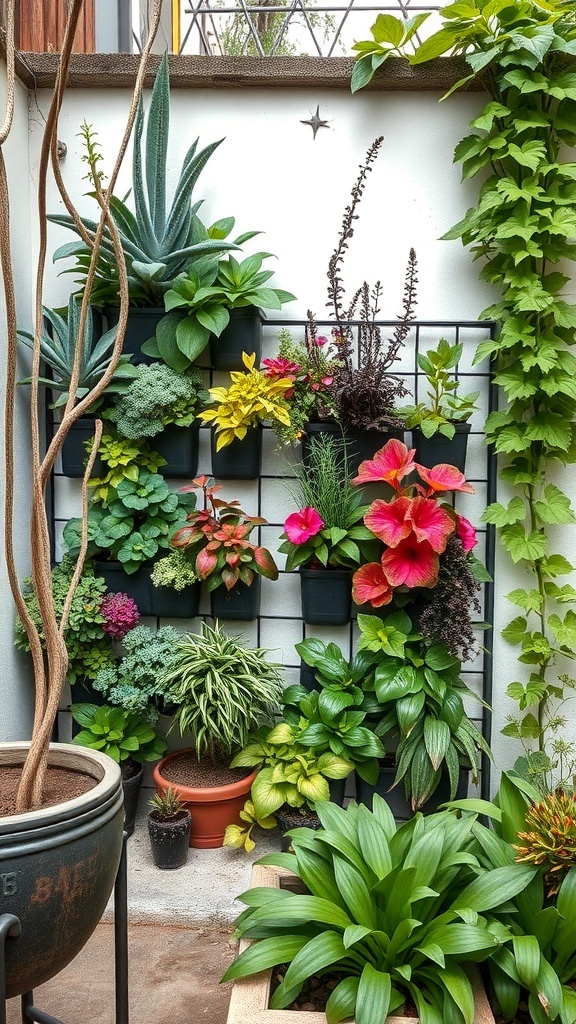
Vertical gardens are a fantastic way to bring greenery into small spaces. They allow you to maximize your gardening potential without needing a lot of ground area. The image showcases a vibrant vertical garden filled with a variety of plants, creating a lively backdrop.
The arrangement features colorful flowers and lush foliage, all neatly organized in wall-mounted pots. This setup not only looks beautiful but also makes it easy to care for the plants. You can choose different types of plants based on your preferences and the sunlight available in your space.
Incorporating a vertical garden can transform a plain wall into a stunning focal point. It’s perfect for balconies, patios, or even indoor spaces. Plus, it’s a great way to improve air quality and add a touch of nature to your home.
Incorporating Edible Plants
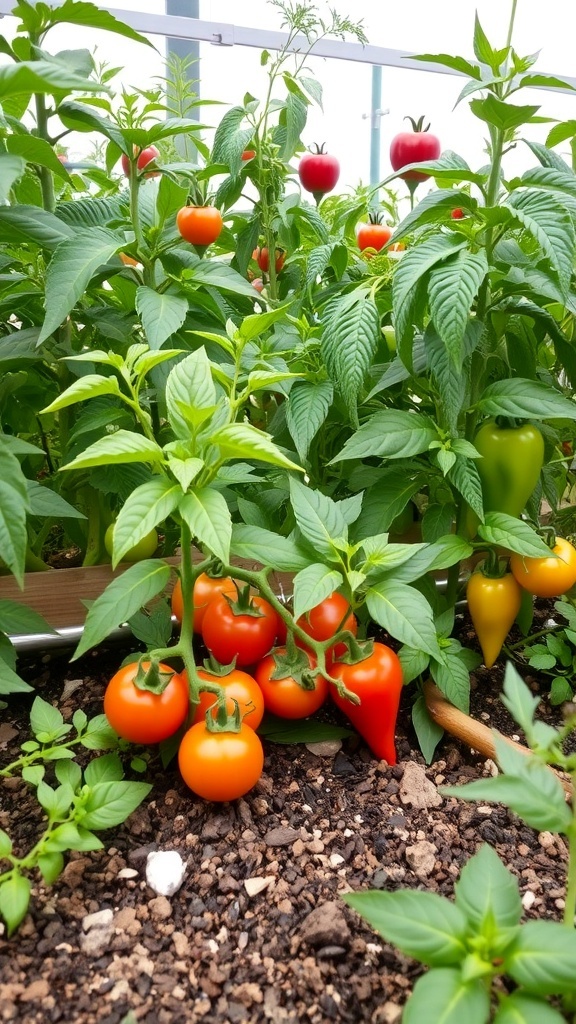
Creating a house garden with edible plants is a fantastic way to enjoy fresh produce right at home. Imagine stepping outside and picking ripe tomatoes straight from the vine. The image shows vibrant tomato plants, full of juicy fruit, surrounded by lush green leaves. This is the essence of a productive garden.
Growing your own food can be rewarding and fun. You can start with easy-to-grow plants like tomatoes and herbs. They don’t require much space and can thrive in pots or garden beds. Just ensure they get enough sunlight and water.
Consider adding herbs like basil or mint alongside your tomatoes. They not only enhance your meals but also attract beneficial insects. Plus, the aroma is delightful! With a little care, your garden can become a source of fresh ingredients for your favorite recipes.
Don’t forget to enjoy the process! Gardening is about nurturing life and watching it grow. Whether you’re a seasoned gardener or a beginner, incorporating edible plants into your garden can bring joy and flavor to your meals.
Seasonal Garden Maintenance Tips
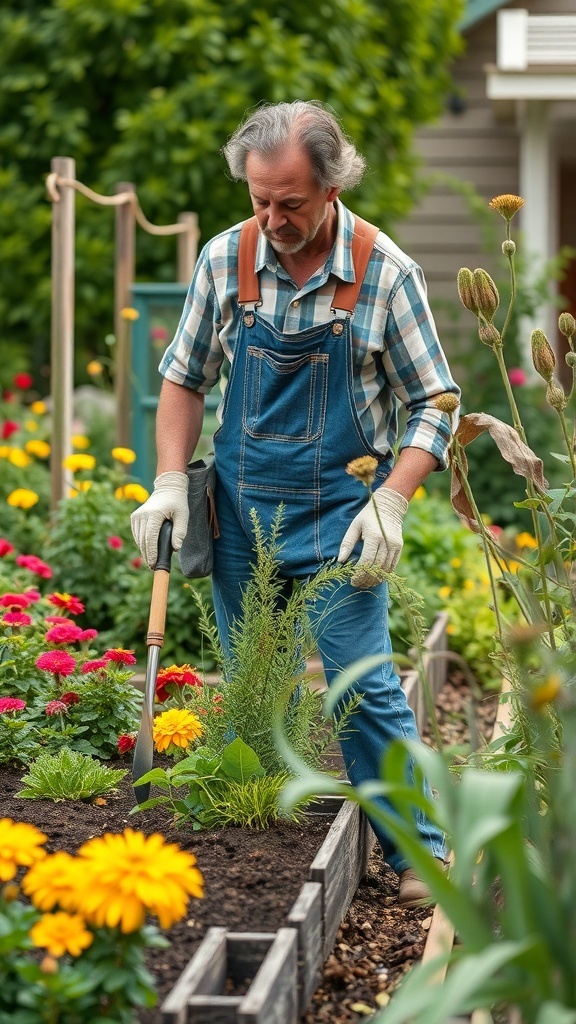
Gardening can be a rewarding hobby, especially when you see your plants thrive. The image shows a gardener tending to a vibrant flower bed, surrounded by colorful blooms. This scene captures the essence of seasonal garden care.
Spring is a great time to start your garden maintenance. Begin by clearing out any dead plants and debris. This helps your flowers and vegetables get the sunlight and nutrients they need. The gardener in the image is using a hoe, which is perfect for loosening the soil and removing weeds.
As the seasons change, keep an eye on watering. Different plants have different needs. Some may require more water during the hot summer months, while others thrive with less. The bright flowers in the garden show how important it is to find the right balance.
In the fall, consider planting bulbs for spring blooms. The gardener’s attention to detail ensures that the garden will be beautiful year after year. Mulching can also help protect your plants during the colder months.
Finally, don’t forget to enjoy your garden! Take time to appreciate the colors and scents. Gardening is not just about work; it’s also about relaxation and connection with nature.
Enhancing Your Garden with Hardscaping
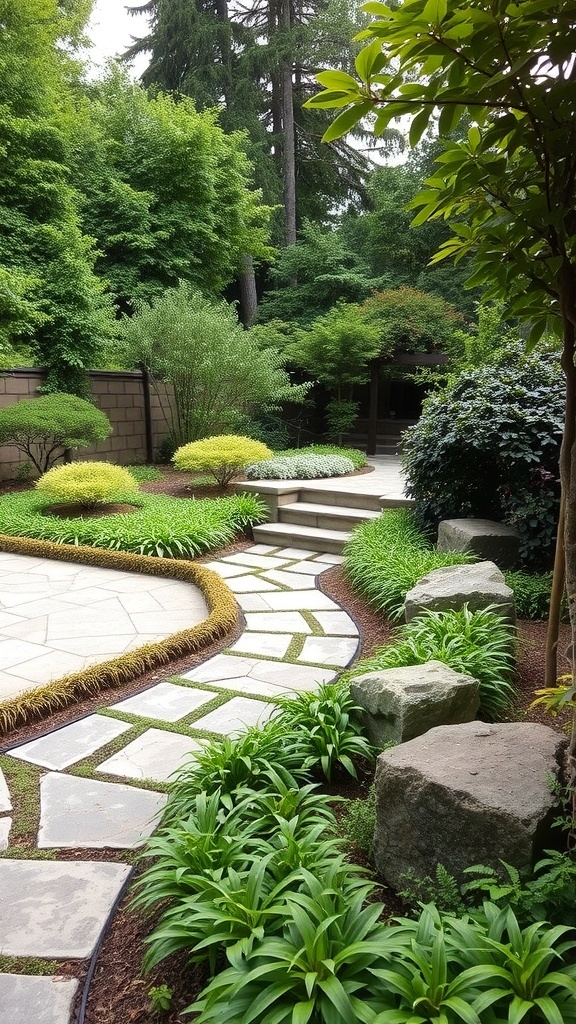
Hardscaping can truly transform your garden into a stunning outdoor space. The image showcases a beautifully designed garden path, winding through lush greenery and stone elements. This kind of layout not only adds visual interest but also creates a functional space for walking and enjoying your garden.
The use of stone pathways is a great way to guide visitors through your garden. The varied shapes and sizes of the stones create a natural look that blends well with the surrounding plants. Notice how the path curves gently, inviting exploration and making the garden feel more expansive.
Incorporating hardscaping elements like rocks and stone can also help define different areas in your garden. The stones in the image serve as natural borders, separating the lush grass from the more structured path. This contrast enhances the overall aesthetic, making each element stand out.
Adding hardscaping features can also reduce maintenance. With a well-planned layout, you can minimize the amount of grass to mow and create areas that require less watering. This is especially beneficial in regions where water conservation is important.
Overall, hardscaping is a fantastic way to enhance your garden. It adds beauty, function, and can even make your outdoor space easier to care for. So, consider incorporating some stone paths or decorative rocks to elevate your garden design!
Choosing the Right Plants for Your Space
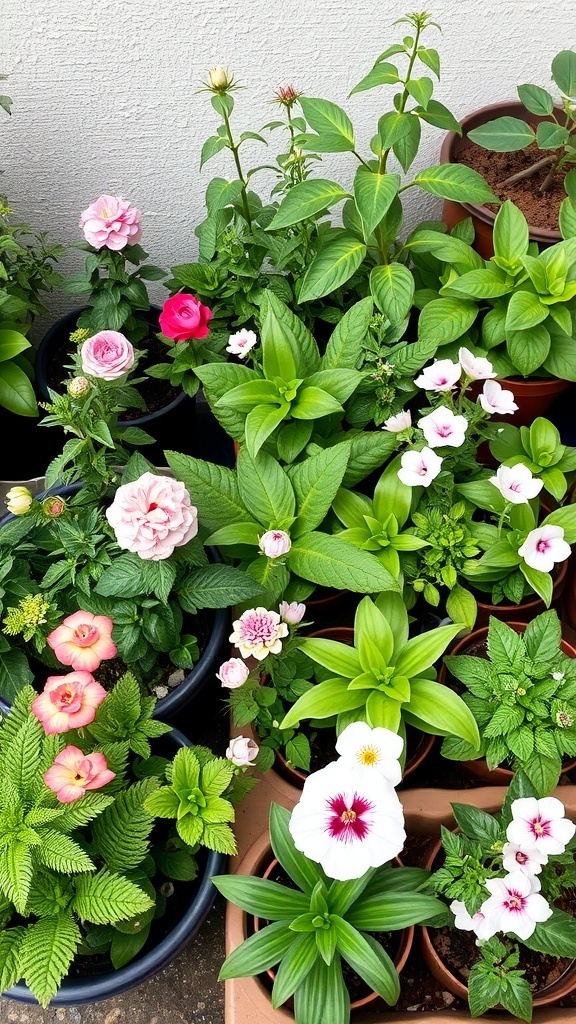
When it comes to creating a lovely garden at home, picking the right plants is key. The image shows a vibrant collection of flowers and greenery, each adding its charm to the overall look. You can see various colors and shapes, making it visually appealing.
Start by thinking about the space you have. Some plants thrive in sunny spots, while others prefer shade. The mix of plants in the image suggests a balance of both, which can help create a lively atmosphere. Consider how much time you want to spend caring for them. Some plants need more attention than others.
Don’t forget about the seasons! Some flowers bloom beautifully in spring, while others shine in summer or fall. This variety can keep your garden looking fresh throughout the year. The plants in the image seem to be chosen for their colorful blooms, which can brighten any space.
Finally, think about how the plants will fit together. Mixing different heights and textures can create a dynamic look. The arrangement in the image shows how layering plants can add depth to your garden. So, take your time choosing the right plants, and enjoy the process!
Sustainable Gardening Practices
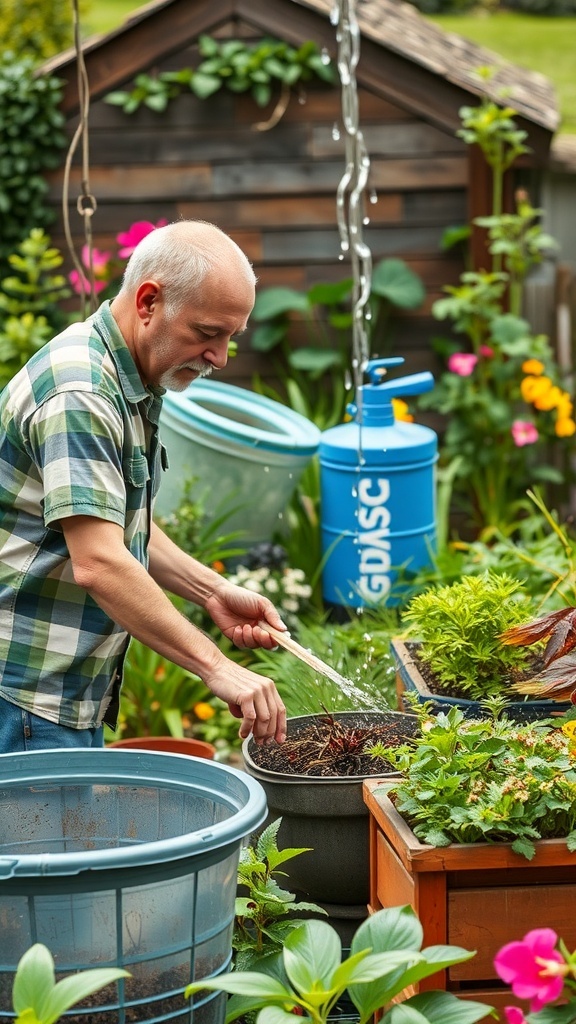
In the image, we see a lovely garden filled with vibrant plants and a person actively tending to the soil. This scene perfectly captures the essence of sustainable gardening. The individual is focused on nurturing the earth, which is a key aspect of eco-friendly practices.
Sustainable gardening is all about working with nature. It encourages the use of native plants, which require less water and maintenance. In the image, the variety of greenery suggests a diverse ecosystem, which is beneficial for local wildlife.
Another important practice is composting. The person in the image appears to be preparing soil, possibly incorporating compost. This not only enriches the soil but also reduces waste. Using organic materials helps keep the garden healthy and thriving.
Water conservation is also vital. The blue water barrel in the background hints at rainwater collection, a smart way to minimize water usage. This practice supports plants during dry spells without relying on municipal water sources.
Overall, the image showcases a beautiful garden that embodies sustainable practices. By nurturing the environment, we can create spaces that are not only beautiful but also beneficial for our planet.
Creating a Wildlife-Friendly Garden
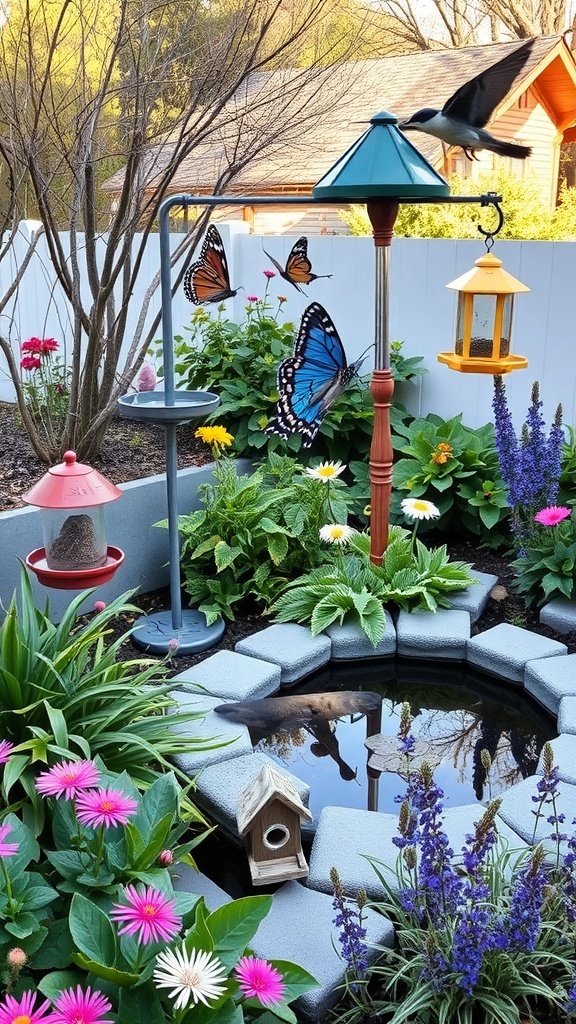
A wildlife-friendly garden is a delightful way to connect with nature right at home. Imagine stepping into a space filled with vibrant flowers, fluttering butterflies, and chirping birds. This image captures that essence perfectly. The colorful blooms attract various pollinators, creating a lively atmosphere.
In the center, a small pond adds a refreshing touch. Water features are essential for attracting wildlife, providing a drinking source and a place for animals to cool off. Surrounding the pond, you can see a mix of plants that offer shelter and food for different creatures.
Bird feeders and baths are also visible, inviting feathered friends to visit. These elements not only enhance the garden’s beauty but also support local ecosystems. By incorporating native plants and reducing chemical use, you can create a safe haven for wildlife.
Creating a wildlife-friendly garden is about balance. It’s a space where you can enjoy the sights and sounds of nature while contributing to its preservation. So, grab your gardening tools and start planting for the critters!
Creating a Cozy Outdoor Retreat
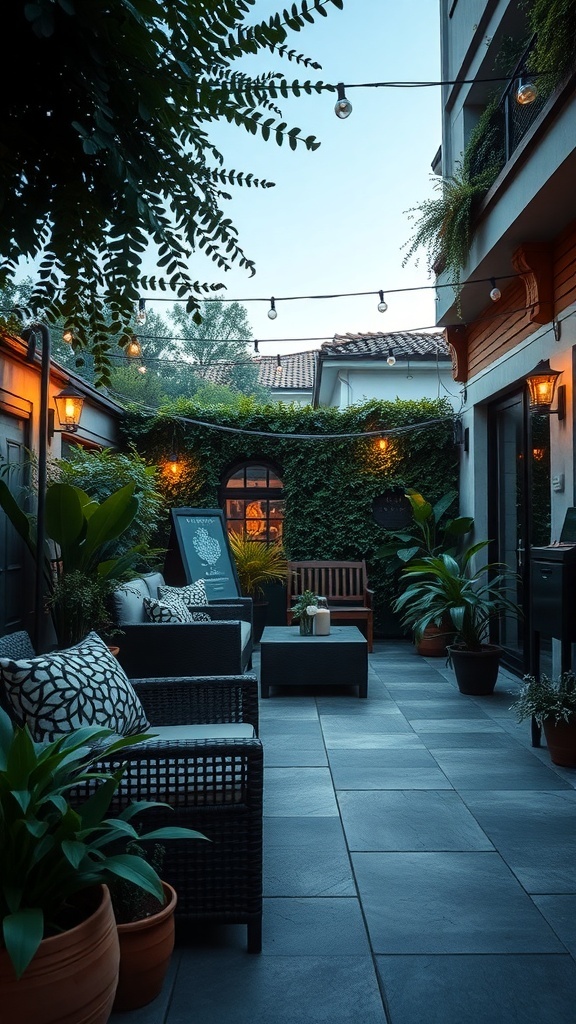
Your garden can become a cozy outdoor retreat with just a few thoughtful touches. Imagine a space where you can relax, enjoy a book, or sip your favorite drink. The right setup makes all the difference.
In the image, you see a charming area filled with lush greenery and comfortable seating. The soft glow from the lights creates a welcoming atmosphere, perfect for evenings spent outdoors. The combination of plants and cozy furniture invites you to unwind.
Consider adding cushions to your seating for extra comfort. A small table can hold your drinks or snacks, making it easy to enjoy your time outside. The plants not only beautify the space but also provide a sense of tranquility.
String lights or lanterns can enhance the mood as the sun sets. They add a warm touch that makes the garden feel like a special place. With these simple elements, your outdoor space can transform into a retreat that feels like home.
Utilizing Garden Lighting for Ambiance
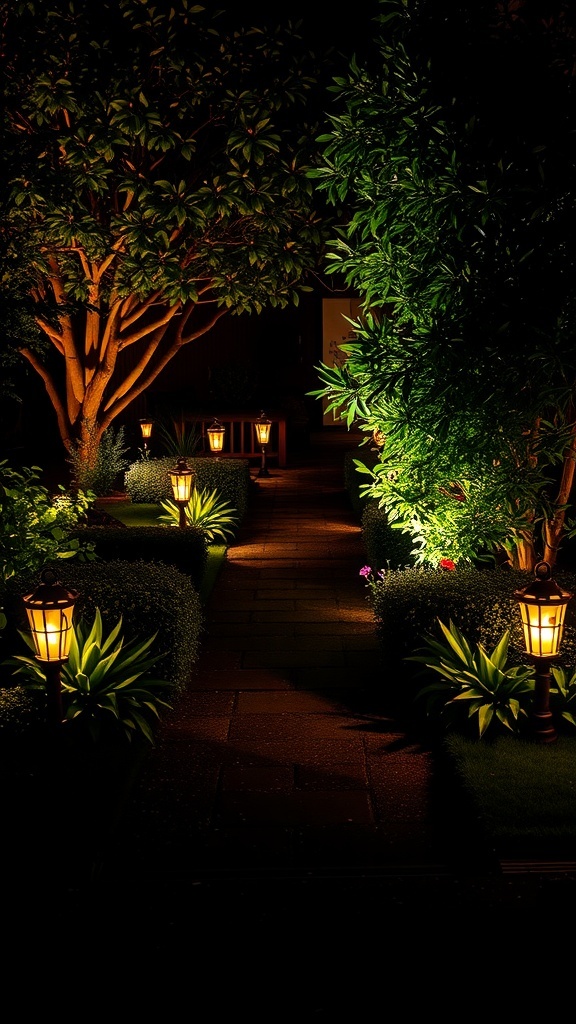
Garden lighting can truly transform your outdoor space. The image shows a beautifully lit pathway, lined with charming lanterns that guide the way. Each light casts a warm glow, creating a welcoming atmosphere.
Notice how the lights highlight the lush greenery and the sturdy tree nearby. This not only enhances the beauty of the plants but also adds depth to the garden. The combination of light and shadow creates a cozy feel, perfect for evening gatherings or quiet moments alone.
When planning your garden lighting, think about the areas you want to emphasize. Pathway lights like those in the image are great for safety and style. They lead the eye and make the garden feel more inviting. You can also consider uplighting for trees or shrubs to create a dramatic effect.
Don’t forget about the types of lights you choose. Solar-powered options are eco-friendly and easy to install. They can add a magical touch without the hassle of wiring. With the right lighting, your garden can shine even after the sun goes down.
Inspiration from Cottage Gardens
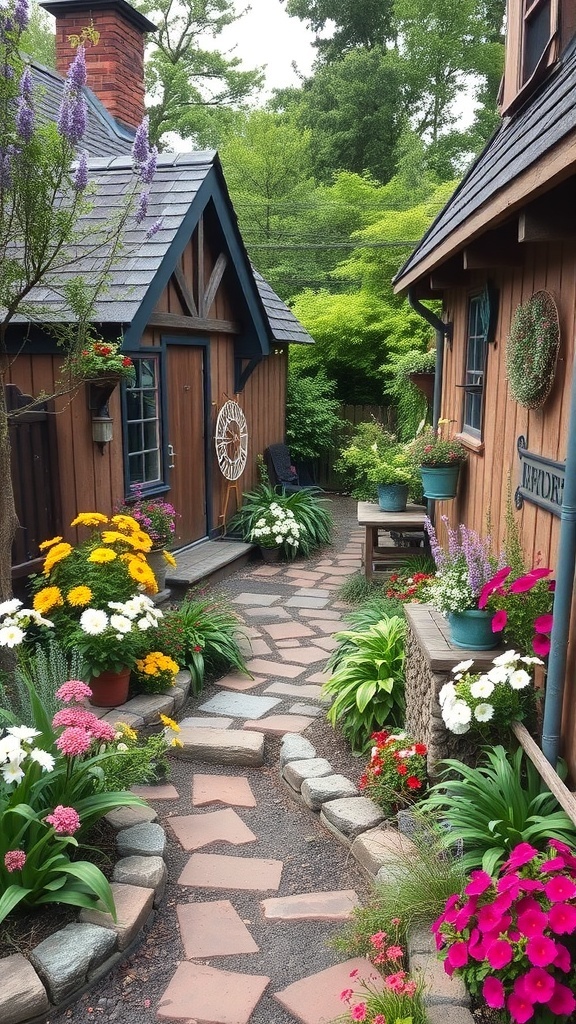
Cottage gardens are charming and inviting, often filled with a mix of colorful flowers and lush greenery. The image captures a delightful pathway lined with vibrant blooms, leading to cozy wooden structures. This scene embodies the essence of a cottage garden, where nature and home blend seamlessly.
The pathway, made of stone, guides visitors through a floral wonderland. Bright yellows, pinks, and whites pop against the earthy tones of the surroundings. Each flower seems to tell a story, inviting you to pause and take in the beauty. The careful arrangement of plants adds a touch of whimsy, making the space feel both organized and free-spirited.
On either side of the path, potted plants add layers of texture and color. The greenery contrasts beautifully with the rustic wooden buildings, creating a warm and welcoming atmosphere. This garden is not just a visual treat; it’s a place to relax and enjoy the simple pleasures of life.
Incorporating elements from this image into your own garden can create a similar sense of peace and joy. Think about adding a winding path, colorful flowers, and cozy seating areas. A cottage garden is all about creating a space that feels like home, where you can unwind and connect with nature.
